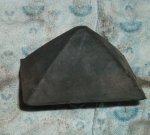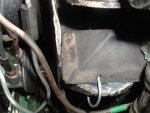Now some of you may recall me mentioning in a thread several months ago that my car was behaving oddly in the front suspension department.
I've just fitted newly reco-d spheres to both ends, and am somewhat bemused at a recurrence of its old habit.
It's like this. When accelerating briskly, or even gently uphill, the nose tends to rise. As it rises, the height corrector senses this and releases pressure, so the nose falls, usually fairly rapidly as one has normally backed off by now. It almost bottoms out, then realises the error of its ways and pumps up to normal height again.
It even happens at walking pace up my steepish driveway.
In the past I've replaced the return pipe (the siamesed one that takes the return from the rear height corrector as well) with one from a donor car. This return pipe definitely has the "bit of wire" inside it to slow the return process.
The height corrector seems to be acting according to Hoyle. The car rides like a DS should. I have a spare HC, that I may try on the car.
The car last exhibited this behaviour when I was running a pair of 800 psi CX spheres in the front. I replaced these with a pair of 400 psi ones and she's behaved fine until now. I put the aberrant behaviour down to the CX spheres having 2mm free-flow orifices.
Having put the correct spheres back in (presumably gassed to 860psi or thereabouts according to the book) I would have expected the beast to behave.
But not so.
Any ideas from the Brains Trust?
Pottsy
I've just fitted newly reco-d spheres to both ends, and am somewhat bemused at a recurrence of its old habit.
It's like this. When accelerating briskly, or even gently uphill, the nose tends to rise. As it rises, the height corrector senses this and releases pressure, so the nose falls, usually fairly rapidly as one has normally backed off by now. It almost bottoms out, then realises the error of its ways and pumps up to normal height again.
It even happens at walking pace up my steepish driveway.
In the past I've replaced the return pipe (the siamesed one that takes the return from the rear height corrector as well) with one from a donor car. This return pipe definitely has the "bit of wire" inside it to slow the return process.
The height corrector seems to be acting according to Hoyle. The car rides like a DS should. I have a spare HC, that I may try on the car.
The car last exhibited this behaviour when I was running a pair of 800 psi CX spheres in the front. I replaced these with a pair of 400 psi ones and she's behaved fine until now. I put the aberrant behaviour down to the CX spheres having 2mm free-flow orifices.
Having put the correct spheres back in (presumably gassed to 860psi or thereabouts according to the book) I would have expected the beast to behave.
But not so.
Any ideas from the Brains Trust?
Pottsy




